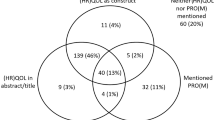Abstract
Objective
The Functional Living Index—Emesis (FLIE) instrument is a validated nausea and vomiting specific quality of life (QOL) tool originally created as a 3-day test of the impact of chemotherapy-induced nausea and vomiting on cancer patients’ daily life. The primary objective of the present study was to retrospectively explore the use of the FLIE from data obtained in a previously published study of patients with gastrointestinal radiation-induced nausea and vomiting (RINV) and compare the extracted symptom clusters on a weekly basis for the entirety of gastrointestinal cancer patients’ radiotherapy treatments.
Methods
QOL was assessed on a weekly basis using the 18-item FLIE questionnaire for patients’ radiotherapy treatments. A principal component analysis with varimax rotation was performed at each visit. The internal consistency and reliability of the derived clusters was assessed with Cronbach’s alpha. Robust relationship and correlation among symptoms was displayed with biplot graphics.
Results
A total of 460 FLIE assessments were completed for the 86 gastrointestinal patients who underwent radiotherapy. Two components were consistently identified except for week 5 where only one component was identified. Component 1 contained the items “Q10–Q18” which included all vomiting items. Component 2 included all nausea items from “Q1 to Q9”. All the variables were well accounted for by two components for most weeks of treatment with excellent internal consistency. Biplots indicate that the two symptom clusters were evident at each week, with the exception of the first week of treatment. Strong correlations were seen between the effect of nausea on patients’ ability to make meals, patients’ ability to do tasks within the home, and patients’ willingness to spend time with family and friends.
Conclusion
The high internal consistency at all timepoints indicates that the FLIE QOL instrument is useful for the RINV population.

Similar content being viewed by others
References
Naeim A, Dy SM, Lorenz KA, Sanati H, Walling A, Asch SM (2008) Evidence-based recommendations for cancer nausea and vomiting. J Clin Oncol 26(23):3903–3910
Vainio A, Auvinen A (1996) Prevalence of symptoms among patients with advanced cancer: an international collaborative study. Symptom Prevalence Group. J Pain Symptom Manage 12(1):3–10
Enblom A, Bergius Axelsson B, Steineck G, Hammar M, Borjeson S (2009) One third of patients with radiotherapy-induced nausea consider their antiemetic treatment insufficient. Support Care Cancer 17(1):23–32
Feyer PC, Maranzano E, Molassiotis A, Roila F, Clark-Snow RA, Jordan K et al (2011) Radiotherapy-induced nausea and vomiting (RINV): MASCC/ESMO guideline for antiemetics in radiotherapy: update 2009. Support Care Cancer 19(Suppl 1):S5–S14
Dennis K, Maranzano E, De Angelis C, Holden L, Wong S, Chow E (2011) Radiotherapy-induced nausea and vomiting. Expert Rev Pharmacoecon Outcomes Res 11(6):685–692
Basch E, Prestrud AA, Hesketh PJ, Kris MG, Feyer PC, Somerfield MR et al (2011) Antiemetics: American Society of Clinical Oncology clinical practice guideline update. J Clin Oncol 29(31):4189–4198
Lindley CM, Hirsch JD, O'Neill CV, Transau MC, Gilbert CS, Osterhaus JT (1992) Quality of life consequences of chemotherapy-induced emesis. Qual Life Res 1(5):331–340
Clavel M, Soukop M, Greenstreet YL (1993) Improved control of emesis and quality of life with ondansetron in breast cancer. Oncology 50(3):180–185
Farley PA, Dempsey CL, Shillington AA, Kulis-Robitaille C, Colgan K, Bernstein G (1997) Patients' self-reported functional status after granisetron or ondansetron therapy to prevent chemotherapy-induced nausea and vomiting at six cancer centers. Am J Health Syst Pharm 54(21):2478–2482
Martin AR, Pearson JD, Cai B, Elmer M, Horgan K, Lindley C (2003) Assessing the impact of chemotherapy-induced nausea and vomiting on patients' daily lives: a modified version of the Functional Living Index—Emesis (FLIE) with 5-day recall. Support Care Cancer 11(8):522–527
Martin AR, Carides AD, Pearson JD, Horgan K, Elmer M, Schmidt C et al (2003) Functional relevance of antiemetic control. Experience using the FLIE questionnaire in a randomised study of the NK-1 antagonist aprepitant. Eur J Cancer 39(10):1395–1401
Dodd MJ, Miaskowski C, Paul SM (2001) Symptom clusters and their effect on the functional status of patients with cancer. Oncol Nurs Forum 28(3):465–470
Poon M, Dennis K, DeAngelis C, Chung H, Stinson J, Zhang L et al (2014) A prospective study of gastrointestinal radiation therapy-induced nausea and vomiting. Support Care Cancer 22(6):1493–1507
Roila F, Herrstedt J, Gralla RJ, Tonato M (2011) Prevention of chemotherapy- and radiotherapy-induced nausea and vomiting: guideline update and results of the Perugia consensus conference. Support Care Cancer 19(Suppl 1):S63–S65
Maranzano E, De Angelis V, Pergolizzi S, Lupattelli M, Frata P, Spagnesi S et al (2010) A prospective observational trial on emesis in radiotherapy: analysis of 1020 patients recruited in 45 Italian radiation oncology centres. Radiother Oncol 94(1):36–41
Kirkbride P, Bezjak A, Pater J, Zee B, Palmer MJ, Wong R et al (2000) Dexamethasone for the prophylaxis of radiation-induced emesis: a National Cancer Institute of Canada Clinical Trials Group phase III study. J Clin Oncol 18(9):1960–1966
National Cancer Institute of Canada Clinical Trials Group (SC19), Wong RK, Paul N, Ding K, Whitehead M, Brundage M et al (2006) 5-Hydroxytryptamine-3 receptor antagonist with or without short-course dexamethasone in the prophylaxis of radiation induced emesis: a placebo-controlled randomized trial of the National Cancer Institute of Canada Clinical Trials Group (SC19). J Clin Oncol 24(21):3458–3464
Decker GM, DeMeyer ES, Kisko DL (2006) Measuring the maintenance of daily life activities using the functional living index—emesis (FLIE) in patients receiving moderately emetogenic chemotherapy. J Support Oncol 4(1):35, -41, 52
Acknowledgments
We thank the generous support of Bratty Family Fund, Michael and Karyn Goldstein Cancer Research Fund, Pulenzas Cancer Research Fund, Joseph and Silvana Melara Cancer Research Fund, and Ofelia Cancer Research Fund.
Conflict of interest
None.
Author information
Authors and Affiliations
Corresponding author
Appendix
Rights and permissions
About this article
Cite this article
Poon, M., Dennis, K., DeAngelis, C. et al. Symptom clusters of gastrointestinal cancer patients undergoing radiotherapy using the Functional Living Index—Emesis (FLIE) quality-of-life tool. Support Care Cancer 23, 2589–2598 (2015). https://doi.org/10.1007/s00520-015-2617-9
Received:
Accepted:
Published:
Issue Date:
DOI: https://doi.org/10.1007/s00520-015-2617-9




